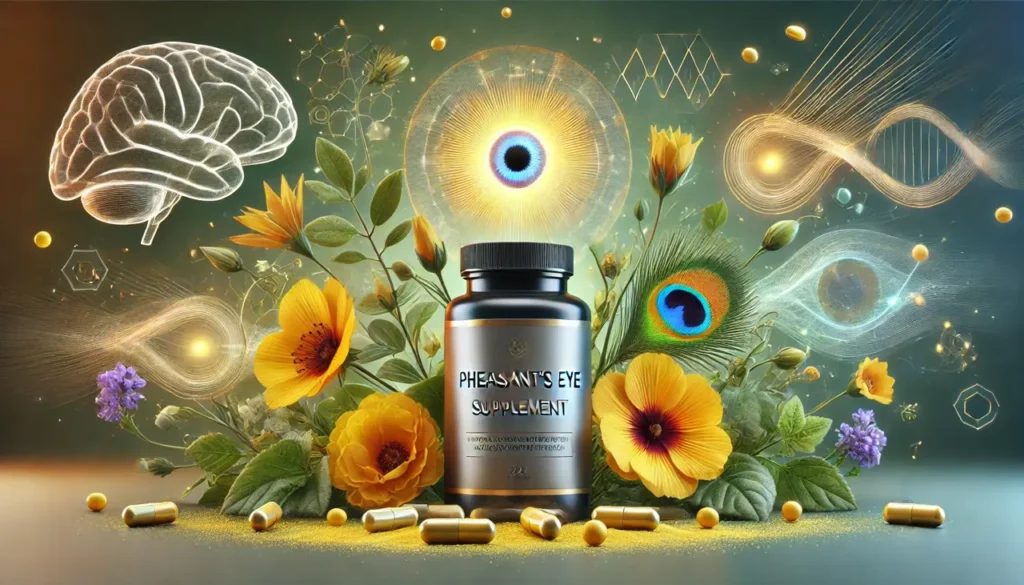Pheasant’s Eye (Adonis vernalis), an herbaceous perennial plant in the Ranunculaceae family, has gained interest for its potential cognitive and cardiovascular benefits, prompting exploration of its suitability as a nootropic supplement. Known for its striking red or yellow flowers, Pheasant’s Eye has a long history in traditional medicine, especially in treating heart conditions. However, with the emergence of nootropic research, Pheasant’s Eye has drawn attention for its potential neuroprotective properties. This article offers an in-depth examination of Pheasant’s Eye, including its source, active compounds, chemical mechanisms, potential nootropic benefits, dosing guidelines, side effects, and possible drug interactions, with an emphasis on safe, effective use.
You May Also Like:
Sources of Pheasant’s Eye
Pheasant’s Eye is native to Europe and parts of Asia, favoring dry, sandy soils, and is often found in grasslands or forest edges. Its use in traditional herbal medicine spans centuries, particularly in the treatment of cardiovascular ailments, as the plant contains cardiotonic glycosides. The plant’s most potent parts, namely the leaves and flowers, are harvested primarily for medical applications. While the raw plant is seldom used due to its toxic potential, extracts are processed to safely utilize its active compounds, including those with potential nootropic effects.
Active Compounds in Pheasant’s Eye
Pheasant’s Eye contains a variety of active compounds, primarily cardiac glycosides, such as adonitoxin, cymarin, and strophanthidin, which contribute to its physiological effects. Cardiac glycosides like adonitoxin and cymarin exhibit significant biological activity, especially regarding heart health. Recent studies also suggest potential benefits for cognitive performance and neuroprotection, although the precise mechanisms remain under investigation. These compounds may have beneficial effects on cognitive function by improving circulation and reducing oxidative stress in neural tissue.

Chemistry of Pheasant’s Eye
The active glycosides in Pheasant’s Eye are structurally similar to digitalis glycosides found in foxglove, known for their heart-regulating properties. Glycosides consist of a sugar (glycone) bound to a non-sugar (aglycone), facilitating their interaction with cellular sodium-potassium ATPase pumps. This action results in increased calcium levels within cells, promoting improved cardiac contractility, which in turn may enhance blood flow, including cerebral circulation.
In addition to cardiac glycosides, Pheasant’s Eye contains flavonoids and phenolic compounds, which possess antioxidant properties. These compounds are particularly relevant for neuroprotection, as antioxidants mitigate oxidative stress—a factor in age-related cognitive decline. The combined antioxidant and circulatory effects make Pheasant’s Eye a promising candidate for cognitive enhancement through improved blood flow and reduced oxidative damage.

Physiological Mechanisms of Pheasant’s Eye in the Body and Brain
Pheasant’s Eye primarily affects the cardiovascular system, which has secondary benefits for brain health. By strengthening heart function and supporting blood flow, Pheasant’s Eye could facilitate better oxygen and nutrient delivery to the brain. Enhanced cerebral circulation may improve cognitive function, memory, and focus, especially in individuals with reduced blood flow due to cardiovascular issues.
The herb’s antioxidant properties, derived mainly from its flavonoids, may protect neuronal cells from oxidative stress. Excessive oxidative damage can impair mitochondrial function, leading to neuronal degeneration and cognitive decline. By neutralizing reactive oxygen species (ROS) and supporting cellular metabolism, Pheasant’s Eye may contribute to maintaining cognitive function.

Nootropic Benefits of Pheasant’s Eye
Although primarily known for its cardiotonic effects, Pheasant’s Eye has potential nootropic benefits worth exploring, particularly in the following areas:
- Improved Cerebral Circulation: By enhancing cardiovascular function, Pheasant’s Eye may promote cerebral blood flow, which is vital for maintaining cognitive processes. Better circulation ensures a steady supply of oxygen and glucose to the brain, enhancing mental clarity, memory, and focus.
- Antioxidant Neuroprotection: The flavonoids in Pheasant’s Eye help neutralize ROS, protecting neural tissue from oxidative damage. This antioxidative effect could slow age-related cognitive decline and reduce the risk of neurodegenerative diseases by preserving cellular integrity.
- Mood and Cognitive Clarity: Improved blood flow and reduced oxidative stress may have cumulative effects on mood and mental sharpness. Individuals with cardiovascular challenges that affect cognition might experience enhanced mental clarity with regular Pheasant’s Eye supplementation.
- Support for Neurotransmitter Function: Although less direct, the cardiac glycosides in Pheasant’s Eye may indirectly influence neurotransmitter production by optimizing cellular energy availability. Neurotransmitter synthesis requires substantial energy, particularly in high-demand areas such as dopamine and serotonin pathways involved in mood regulation and motivation.
- Enhanced Synaptic Plasticity: By improving overall cellular health and circulation, Pheasant’s Eye may support synaptic plasticity, which is crucial for learning and memory. Improved synaptic plasticity can make the brain more adaptable to new information and help strengthen long-term memory formation.
- Reduction of Inflammation: Pheasant’s Eye contains compounds that may exert anti-inflammatory effects, which are beneficial for brain health. Chronic inflammation has been linked to cognitive decline and neurodegenerative diseases. By reducing inflammation, Pheasant’s Eye could protect brain cells, helping to maintain cognitive function and prevent mental fatigue.
- Improved Stress Resilience: Certain compounds in Pheasant’s Eye may help modulate the stress response by impacting the hypothalamic-pituitary-adrenal (HPA) axis. This could make individuals more resilient to stress, potentially reducing cortisol levels and thereby protecting brain cells from the adverse effects of chronic stress, such as memory impairment and emotional dysregulation.

Dosage and Supplementation Guidelines
Since Pheasant’s Eye is a potent herb with cardiotonic properties, careful dosing is essential. Supplementation generally involves using standardized extracts containing specific glycoside concentrations. However, research on optimal nootropic dosing is limited, as the herb is primarily studied for its effects on heart health.
General Dosage for Nootropic Purposes
For cognitive enhancement and neuroprotection, low to moderate doses are recommended. These may range between 10-30 mg of extract per day, though specific dosages vary depending on the concentration of active glycosides. Higher doses are typically reserved for cardiac conditions under medical supervision, as excessive intake can lead to toxicity.
Forms of Pheasant’s Eye Supplements
Pheasant’s Eye is available in capsules, tinctures, and teas, with capsules and tinctures preferred for precise dosing. Standardized extracts are generally safer and provide consistent glycoside levels compared to raw plant preparations. For nootropic purposes, capsules or liquid extracts standardized to specific glycoside levels allow more controlled intake and minimize the risk of toxicity.
Support Stress Relief and Brain Health with Powerful Rhodiola Rosea—Order Today on Amazon!

Side Effects and Safety
Pheasant’s Eye, like other cardiac glycoside-containing plants, has a narrow therapeutic window. While moderate doses can benefit cognitive function indirectly, excessive intake may lead to serious side effects. Common adverse reactions include:
- Gastrointestinal Distress: Nausea, vomiting, and abdominal pain may occur with higher doses or in sensitive individuals.
- Cardiac Arrhythmias: Due to its impact on the heart, excessive Pheasant’s Eye can induce arrhythmias, dizziness, and palpitations. This effect is more likely with higher glycoside concentrations.
- Neurological Effects: While beneficial in low doses, high doses may cause confusion, dizziness, or headaches due to overstimulation of sodium-potassium ATPase activity in neurons.
Recommended Safety Measures
- Gradual Introduction: Begin with the lowest effective dose and gradually increase if needed while monitoring for side effects.
- Avoidance by Vulnerable Populations: Pheasant’s Eye is contraindicated in individuals with preexisting heart conditions unless prescribed by a healthcare professional.
- Pregnancy and Lactation: Pheasant’s Eye is generally not recommended during pregnancy or lactation due to its potency and lack of safety data for these populations.
Interactions with Other Supplements and Medications
Due to its potent cardiac effects, Pheasant’s Eye interacts with various medications and supplements, which may increase the risk of adverse effects.
- Cardiac Medications: Pheasant’s Eye should not be taken with other cardiac glycosides, such as digoxin, as this may amplify their effects, leading to arrhythmias or cardiac distress.
- Antihypertensive Drugs: When combined with antihypertensive medications, Pheasant’s Eye may excessively lower blood pressure, leading to hypotension.
- Diuretics: Co-administration with diuretics can increase potassium excretion, which may result in hypokalemia—a condition that can exacerbate the cardiac effects of Pheasant’s Eye.
- Nootropics and Stimulants: Combining Pheasant’s Eye with stimulating nootropics or supplements that increase heart rate, such as caffeine or yohimbine, may elevate the risk of palpitations or arrhythmias.
- Herbal Interactions: Other herbs containing cardiac glycosides (e.g., foxglove) or stimulants (e.g., ginseng) may intensify Pheasant’s Eye’s effects, risking overdose.
Risks for Individuals with Certain Health Conditions
Due to its potent glycoside content, Pheasant’s Eye is contraindicated in several health conditions. Individuals with any of the following conditions should avoid using Pheasant’s Eye unless supervised by a healthcare provider:
- Cardiovascular Disease: For individuals with preexisting cardiovascular conditions, Pheasant’s Eye poses an elevated risk of arrhythmias or worsened symptoms.
- Kidney Disease: Renal impairment may alter the elimination of cardiac glycosides, increasing the risk of toxic buildup.
- Electrolyte Imbalances: Since Pheasant’s Eye interacts with sodium-potassium ATPase, individuals with imbalances, such as hypokalemia or hyperkalemia, may experience exacerbated side effects.
Fuel Your Mind and Boost Cognitive Performance with High-Quality Bacopa Monnieri—Shop Now on Amazon!

Conclusion: Should You Consider Pheasant’s Eye as a Nootropic?
Pheasant’s Eye presents a fascinating profile as a potential nootropic, primarily through its circulatory and antioxidative effects. Enhanced cerebral blood flow, antioxidant properties, and mild cardiotonic action suggest possible benefits for cognitive clarity and protection against oxidative damage. However, its potent cardiac glycosides also present significant risks, particularly for individuals with cardiovascular issues or electrolyte imbalances.
For those seeking cognitive enhancement, Pheasant’s Eye may offer some indirect benefits; however, due to safety concerns, its use should be approached with caution and preferably under the guidance of a healthcare professional. Further research into optimal dosing, nootropic efficacy, and safer, modified extracts is warranted. Until then, low doses within safe limits may offer mild cognitive benefits for suitable users while respecting the narrow safety margin of this powerful herb.

References:
- Pheasant’s Eye. Retrieved from: https://www.rxlist.com/supplements/pheasants_eye.htm
- Adonis – an overview.. Retrieved from: https://www.sciencedirect.com/topics/immunology-and-microbiology/adonis
- Exploring the Benefits of Small pheasant’s-eye: An Underrated Herbal Treasure. Retrieved from: https://www.picturethisai.com/benefits/Adonis_microcarpa.html
- Facts and benefits of Pheasant’s Eye. Retrieved from: https://www.healthbenefitstimes.com/pheasants-eye/
Important Note: The information contained in this article is for general informational purposes only, and should not be construed as health or medical advice, nor is it intended to diagnose, prevent, treat, or cure any disease or health condition. Before embarking on any diet, fitness regimen, or program of nutritional supplementation, it is advisable to consult your healthcare professional in order to determine its safety and probable efficacy in terms of your individual state of health.
Regarding Nutritional Supplements Or Other Non-Prescription Health Products: If any nutritional supplements or other non-prescription health products are mentioned in the foregoing article, any claims or statements made about them have not been evaluated by the U.S. Food and Drug Administration, and such nutritional supplements or other health products are not intended to diagnose, treat, cure, or prevent any disease.


